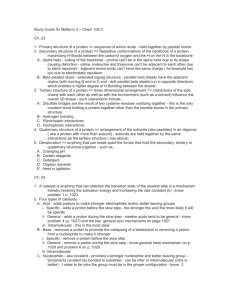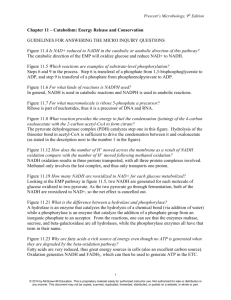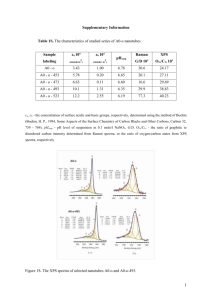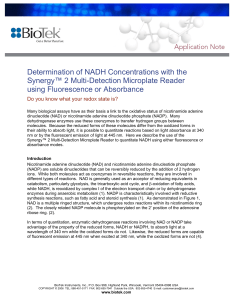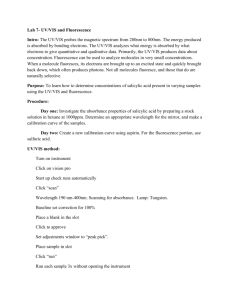Determination of NADH or NADPH Concentrations
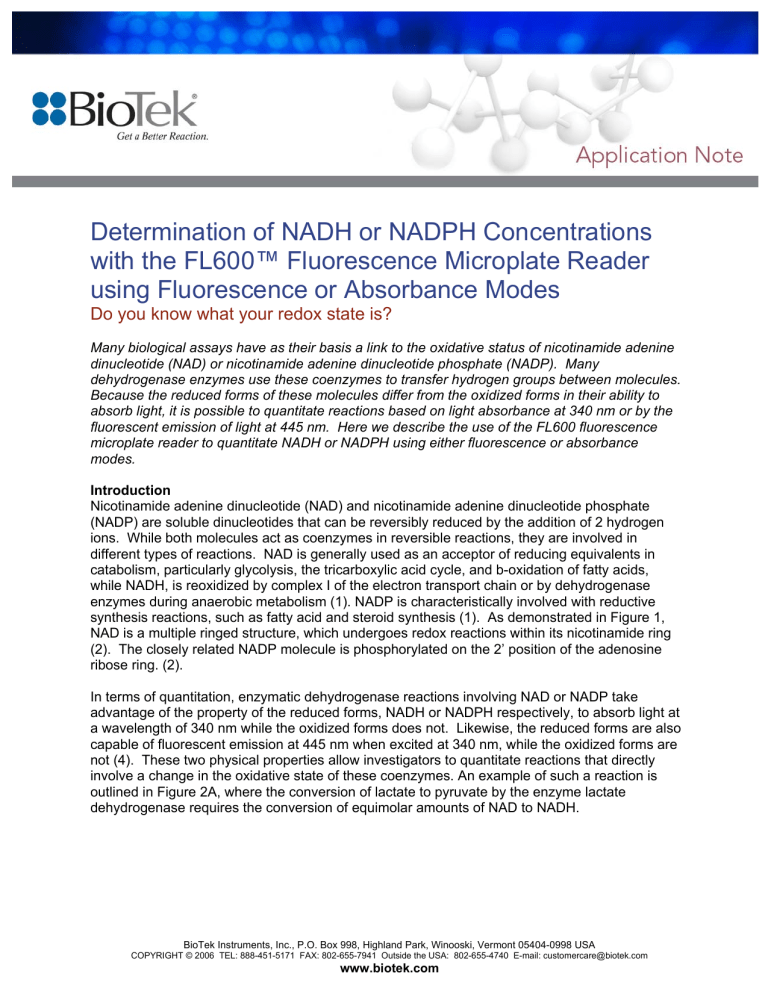
Determination of NADH or NADPH Concentrations with the FL600™ Fluorescence Microplate Reader using Fluorescence or Absorbance Modes
Do you know what your redox state is?
Many biological assays have as their basis a link to the oxidative status of nicotinamide adenine dinucleotide (NAD) or nicotinamide adenine dinucleotide phosphate (NADP). Many dehydrogenase enzymes use these coenzymes to transfer hydrogen groups between molecules.
Because the reduced forms of these molecules differ from the oxidized forms in their ability to absorb light, it is possible to quantitate reactions based on light absorbance at 340 nm or by the fluorescent emission of light at 445 nm. Here we describe the use of the FL600 fluorescence microplate reader to quantitate NADH or NADPH using either fluorescence or absorbance modes.
Introduction
Nicotinamide adenine dinucleotide (NAD) and nicotinamide adenine dinucleotide phosphate
(NADP) are soluble dinucleotides that can be reversibly reduced by the addition of 2 hydrogen ions. While both molecules act as coenzymes in reversible reactions, they are involved in different types of reactions. NAD is generally used as an acceptor of reducing equivalents in catabolism, particularly glycolysis, the tricarboxylic acid cycle, and b-oxidation of fatty acids, while NADH, is reoxidized by complex I of the electron transport chain or by dehydrogenase enzymes during anaerobic metabolism (1). NADP is characteristically involved with reductive synthesis reactions, such as fatty acid and steroid synthesis (1). As demonstrated in Figure 1,
NAD is a multiple ringed structure, which undergoes redox reactions within its nicotinamide ring
(2). The closely related NADP molecule is phosphorylated on the 2’ position of the adenosine ribose ring. (2).
In terms of quantitation, enzymatic dehydrogenase reactions involving NAD or NADP take advantage of the property of the reduced forms, NADH or NADPH respectively, to absorb light at a wavelength of 340 nm while the oxidized forms does not. Likewise, the reduced forms are also capable of fluorescent emission at 445 nm when excited at 340 nm, while the oxidized forms are not (4). These two physical properties allow investigators to quantitate reactions that directly involve a change in the oxidative state of these coenzymes. An example of such a reaction is outlined in Figure 2A, where the conversion of lactate to pyruvate by the enzyme lactate dehydrogenase requires the conversion of equimolar amounts of NAD to NADH.
BioTek Instruments, Inc., P.O. Box 998, Highland Park, Winooski, Vermont 05404-0998 USA
COPYRIGHT © 2006 TEL: 888-451-5171 FAX: 802-655-7941 Outside the USA: 802-655-4740 E-mail: customercare@biotek.com www.biotek.com
Figure 1. Structure and redox reaction of nicotinamide adenine dinucleotide (NAD+). Figure (A)
Depicts the chemical structure of the nicotinamide adenine dinucleotide (NAD+) molecule, while (B) demonstrates the bi-directional redox-reaction between NAD and NADH that is catalyzed by dehydrogenase enzymes.
Figure 2. Outline of two reactions using NAD+ as a coenzyme. Reaction A demonstrates a reaction directly linked with the reduction of the coenzyme NAD+. Lactate can be quantitated by formation of
NADH as a result of the enzymatic conversion of lactate to pyruvate by the enzyme lactate dehydrogenase. Reaction B depicts a coupled reaction where ATP can be quantitated by a loss of NADH.
One of the products of the initial reaction catalyzed by phosphoglycerate phosphokinase (PGK) is utilized as a substrate in a second reaction involving NADH that is catalyzed by glyceraldehyde phosphate dehydrogenase (GAPD).
Reactions of enzymes other than dehydrogenases, which are not directly linked with these coenzymes, can also be measured by coupling their product to a dehydrogenase, which uses that product as a substrate (Figure 2B). When the dehydrogenase is in excess, the rate of appearance or disappearance of NADH may then be used to quantify an enzyme that itself does not use NADH as a substrate.
Materials and Methods
Pre-weighed NADH, NAD, NADPH, and NADP were purchased from Sigma Chemical Company
(St. Louis, MO). The 96 well clear microplates, catalogue number CFCP N96, were purchased from Biosearch, (Bedford, MA). Stock solutions (1 mg/ml) of each compound were made using
10 mM Tris pH 8.0 as the buffer. The concentration of NADH and NADPH solutions was checked by absorbance at 340 nm using a Shimadzu UV-120-02 spectrophotometer. Further dilutions were then made using 10 mM Tris, pH 8.0, as the diluent and 200 ml aliquots of each dilution were dispensed into microplate wells in replicates of 4. Absorbance measurements were made using an FL600FA fluorescence microplate reader using a 340 nm absorbance filter with a
10 nm bandwidth. The fluorescence of all compounds was determined with the same microplate reader using a 340 nm, 30 nm bandwidth, excitation filter and a 440 nm, 30 nm bandwidth
emission filter. The sensitivity setting was at 155 and the data collected from the top with a 3 mm probe using static sampling with a 0.35 second delay, 50 reads per well.
Results
The absorbance was determined for NADH and NAD concentrations ranging from 0 to 500 mg/ml (Figure 3). Over this range the absorbance increased in a linear fashion with the NADH samples, while there was virtually no increase in absorbance observed with the NAD+ samples.
Using KC4 data reduction software package (BioTek Instruments, Winooski, VT) a least means squared linear regression analysis can be generated with a coefficient of determination (r2) value of 0.9998. The average coefficient of variation (%CV) of the standards was 3%, with the greatest percent variation taking place in the lower NADH concentrations tested (data not shown). Under appropriate conditions, NADH concentrations as low as 975 ng/ml were found to be statistically different (p=0.003) from the 10 mM Tris buffer only (0 mg/ml) control. Concentrations greater than 500 mg/ml were found to exceed the FL600’s linear range for absorbance (data not shown).
The absorbance of NADP and NADPH for concentrations ranging from 0 to 500 mg/ml was also investigated (Figure 4). Again, a linear increase in absorbance with increasing concentration in the reduced form (NADPH) was observed, while the oxidized form, NADP, showed no absorbance. A least means squared linear regression analysis can be used with a high degree of confidence, as the coefficient of determination (r2) value was 0.9999 for the NADPH data.
Figure 3. NADH concentration curve measured using absorbance at 340 nm. Serial dilutions of
NADH ranging from 0-500 mg/ml were made using 10 mM Tris pH 8.0 aqueous buffer as the diluent. The absorbance was determined using an FL600 with a 340 nm absorbance filter. KC4 data reduction software was used for reader control and data capture, as well as linear regression analysis of the data.
When the fluorescence of NADH was determined for concentrations ranging from 0 to 1000 mg/ml a hyperbolic response was observed (Figure 5). The oxidized form, NAD+, does not exhibit any fluorescent emission at 440 nm when excited by 340 nm light. As a result of incomplete light saturation of the NADH at the excitation wavelength of 340 nm, a quenching of
NADH fluorescence is observed at higher NADH concentrations.
Figure 4 NADPH concentration curve measured using absorbance at 340 nm. Serial dilutions of
NADPH ranging from 0-500 mg/ml were made using 10 mM Tris pH 8.0 aqueous buffer as the diluent.
The absorbance was determined using an FL600 with a 340 nm absorbance filter. KC4 data reduction software was used for reader control and data capture, as well as linear regression analysis of the data.
Figure 5. NADH concentration curve measured using fluorescence. Serial dilutions of NADH ranging from 0-1000 mg/ml were made using 10 mM Tris pH 8.0 aqueous buffer as the diluent. The fluorescence was determined using an FL600. KC4 data reduction software was used for reader control and data capture, as well as a 4-parameter logistic fit best fit of the data.
Nevertheless, a very good correlation between concentration and fluorescence is observed.
Unknown concentrations can safely be determined in this range with a high degree of confidence as the coefficient of determination (r2) value was calculated to be 0.9996.
The fluorescence of NADPH and NADP were examined for concentrations ranging from 0 to 500 mg/ml. In this concentration range the fluorescence of NADPH was found to increase in a hyperbolic fashion. Similarly, the oxidized form of the coenzyme demonstrated little fluorescence regardless of the concentration.
Figure 6. NADPH concentration curve measured using fluorescence. Serial dilutions of NADPH ranging from 0-500 mg/ml were made using 10 mM Tris pH 8.0 aqueous buffer as the diluent. The fluorescence was determined using an FL600. KC4 data reduction software was used for reader control and data capture, as well as, 4-parameter logistic fit best fit of the data.
When lower NADH concentrations are measured (0-30 mg/ml) a linear response is seen (Figure
7). Linear regression analysis of these data suggests that low concentrations a straight-line function best describe the relationship between NADH concentration and fluorescence. Under appropriate sensitivity settings, NADH concentrations as low as 97 ng/ml were found to be statistically different (p=0.003) from the 10 mM Tris buffer only (0 mg/ml) control (Figure 7).
Taking into consideration the sample volume in a well this detection limit represents the determination of as little as 2.56 x10-11 moles of NADH. Although not examined, similar results would be expected for the determination of NADPH.
Discussion
Traditionally, enzymatic reactions involving NADH or NADPH have been quantitated using changes in absorbance at 340 nm. The reduced form of the coenzymes also has the characteristic of being fluorescent when excited with 340 nm light. In this application note we have described how both methods of quantitating NADH or its phosphorylated relative, NADPH, in solution can be performed with the same instrument.
Figure 7. Linearity of low NADH concentrations. Dilutions of NADH ranging from 0-32.5 mg/ml were made and their fluorescence determined. The fluorescence was determined using an FL600. KC4 data reduction software was used for reader control and data capture, as well as, sample blanking and linear regression analysis.
Despite the smaller probe size, (3 mm vs. 5 mm), when using fluorescence as a means to detect
NADH or NADPH, top read configuration is slightly superior to reading from the bottom. This
may be the result of absorption of a portion of the excitation light by the microplate itself. The plates utilized for this study have been optimized for low background fluorescence rather than superior light transparency in the UV light range.
Not surprisingly, detection of low concentrations of NADH and NADPH is more successful when fluorescence is utilized. The ability of small amounts of light signal to be amplified by the photomultiplier enables their detection against a low background. When using absorbance to measure low levels of the compounds, the opposite is true; very little light signal is being absorbed against a high background. In terms of detection limits, the use of fluorescence to determine NADH and NADPH concentrations translates to approximately an order of magnitude greater sensitivity than absorbance.
In this application note we describe the use of the FL600 fluorescence microplate reader to monitor changes in NADH or NADPH levels using either absorbance or fluorescence modes.
Although we have only demonstrated the capability of measuring different dilutions of NADH or
NADPH, the concept can be utilized to quantitate many different enzymatic assays that utilize these coenzymes for hydrogen ion transfer.
Some assays use the reaction kinetics of the increase or decrease in the amounts of the reduced form of these coenzymes rather than an endpoint determination. Although we have not demonstrated the use of kinetic reactions in this application note, the FL600 in conjunction with
KC4 data reduction software is capable of making the kinetic determinations (either absorbance or fluorescence) and performing all of the necessary reaction rate calculations (5).
References
(1) Stryer, L. (1998) Biochemistry 3rd ed., W,H. Freman and Co., New York, NY.
(2) Kendrew, J and E. Lawrence, eds. (1994) The Encyclopedia of Molecular Biology, Blackwell
Science Ltd, Cambridge, MA.
(3) Martin, D., P. Mayes, V. Rodwell Eds. (1981) Harper’s Review of Biochemistry 18th ed.
Lange Medical Publications, Los Altos CA.
(4) Rost, F.W.D. (1995) Fluorescence Microscopy vol II. Cambridge University Press, New York,
NY.
(5) Held. P. (1997) “Kinetic Analysis of b-Galactosidase Activity using the PowerWave 200 in
Conjunction with KC4 Data Reduction Software”, BioTek Instruments application note.
Paul Held Ph.D.
Senior Scientist & Applications Lab Manager
Rev. 2-21-01
